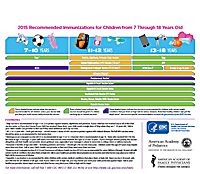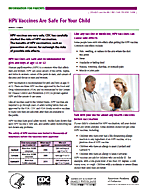Human Papillomavirus (HPV) Vaccine Safety
See CDC’s Immunization Schedule to view HPV vaccine recommendations
HPV and How to Protect Against It
Human papillomavirus (HPV) infection is very common. Most people—about 9 in 10—will get an HPV infection at some point in their lives. HPV infections can cause health problems, including several kinds of cancer in both women and men. There are safe and effective vaccines recommended to prevent these health problems from happening.
HPV Vaccine Side Effects
The HPV vaccine is very safe, and it is effective at preventing HPV. Vaccines, like any medicine, can have side effects. Many people who get the HPV vaccine have no side effects at all. Some people report having very mild side effects, like a sore arm from the shot. The most common side effects are usually mild.
Common Side Effects of HPV Vaccine:
- Pain, redness, or swelling in the arm where the shot was given
- Fever
- Headache or feeling tired
- Nausea
- Muscle or joint pain
Brief fainting spells and related symptoms (such as jerking movements) can happen after any medical procedure, including vaccination. Sitting or lying down for about 15 minutes after a vaccination can help prevent fainting and injuries caused by falls.
On very rare occasions, severe (anaphylactic) allergic reactions may occur after vaccination. People with severe allergies to any component of a vaccine should not receive that vaccine.
Available HPV Vaccines
There are three licensed HPV vaccines available in the United States. CDC recommends that anyone starting the series before their 15th birthday receives two doses of HPV vaccine at least six months after the first dose. Adolescents who receive their two doses less than five months apart will require a third dose of HPV vaccine.
Teens and young adults who start the series at ages 15 through 26 years still need three doses three doses of HPV vaccine. Also, three doses are still recommended for people with certain immunocompromising conditions aged 9 through 26 years.
- Gardasil 9: FDA approved Gardasil 9 for use in 2014. The safety of Gardasil 9 was studied in clinical trials with more than 15,000 participants before it was licensed and continues to be monitored. Gardasil 9 protects against HPV types 6, 11, 16, 18, 31, 33, 45, 52, and 58.
- Gardasil: FDA approved Gardasil for use in 2006. The safety of Gardasil was studied in clinical trials with more than 29,000 participants before it was licensed and continues to be monitored. Gardasil protects against HPV types 6, 11, 16, and 18.
How CDC Monitors the Safety of HPV Vaccines
CDC and FDA monitor the safety of vaccines after they are licensed. Any problems detected with these vaccines will be reported to health officials, health care providers, and the public.
CDC uses three systems to monitor vaccine safety:
- The Vaccine Adverse Event Reporting System (VAERS) – an early warning system that helps CDC and FDA monitor problems following vaccination. Anyone can report suspected vaccine reactions and issues to VAERS.
- The Vaccine Safety Datalink (VSD) – a collaboration between CDC and several health care organizations that allows ongoing monitoring and proactive searches of vaccine-related data.
- The Clinical Immunization Safety Assessment (CISA) Project – a partnership between CDC and several medical centers that conduct clinical research on vaccine-associated health risks in certain groups of people.
A Closer Look at the Safety Data
- In 2014, before it was licensed by the FDA, the safety of Gardasil 9 was evaluated across seven studies. The safety findings from these pre-licensure studies show it has a similar safety profile to Gardasil. The main findings from these studies are:
- The most common side effect reported was pain, swelling, and redness in the arm where the shot was given.
- These mild side effects may occur more often after Gardasil 9 vaccination than after Gardasil. Women and girls who received Gardasil 9 reported higher rates of swelling and redness where the shot was given than those who received Gardasil. Reports of swelling and redness also increased with each following dose for those receiving Gardasil 9.
- In 2014, CDC published a report analyzing health events reported to VAERS following Gardasil vaccination from June 2006 through March 2014. About 92% of the Gardasil reports were classified as non-serious.
- The most common adverse events reported were:
- Syncope (fainting)
- Dizziness
- Nausea
- Headache
- Fever
- Injection site reactions (pain, swelling, and redness)
Although rare, fainting was found to happen after HPV vaccination. In response, FDA changed Gardasil’s guidance for doctors to include information about preventing falls and injuries from fainting. CDC and the Advisory Committee on Immunization Practices included this guidance in the recommendations for HPV vaccination. Based on these recommendations, health care professionals should administer HPV vaccinations while the patient is seated or lying down. The patient should then remain seated and be observed for 15 minutes. CDC continues to remind doctors and nurses to observe this guidance and to share this information with all their patients.
- In 2011, the Institute of Medicine (IOM) reviewed published and unpublished studies of the safety of eight vaccines, including HPV, and published a report, Adverse Effects of Vaccines: Evidence and Causality. This report concluded:
- Syncope (fainting) may be caused by injected vaccines, including HPV vaccines.
- Some people are allergic to certain ingredients in vaccines, and vaccines, including HPV vaccines, can cause anaphylaxis among people with severe allergies. This is very rare. People with severe allergies to any component of a vaccine should not receive that vaccine.
Ongoing Safety Monitoring and Studies
Ongoing HPV vaccine safety monitoring efforts include:
- Review of reports to VAERS to search for unusual adverse events or changing patterns of adverse events
- Continued monitoring and research in VSD, including the new Gardasil 9 vaccine
- Regular consultation with CISA experts, as needed, on clinically complex adverse events
More Resources
- Frequently Asked Questions about HPV Vaccine Safety
- HPV Vaccine: Who Should Not Get Vaccinated
- CDC HPV Information Portal
- HPV Vaccine Information Statements
- Tips and Time-savers for Talking with Parents about HPV Vaccine [PDF – 202 KB]
- HPV Vaccine Recommendations of the Advisory Committee for Immunization Practices (ACIP)
Related Scientific Articles
Gee J, Naleway A, Shui I, Baggs J, Yinc R, Lic R, et al. Monitoring the safety of quadrivalent human papillomavirus vaccine: Findings from the Vaccine Safety Datalink, Vaccine. 2011;29(46)8279-8284.
Markowitz LE, Dunne EF, Saraiya M, Chesson HW, Curtis CR, Gee J, et al. Human papillomavirus vaccination: Recommendations of the Advisory Committee on Immunization Practices (ACIP). MMWR. 2014;63(RR05);1-30.
Petrosky E, Bocchini JA Jr, Hariri S, Chesson H, Curtis CR, Saraiya M, et al. Use of 9-Valent human papillomavirus (HPV) vaccine: Updated HPV vaccination recommendations of the Advisory Committee on Immunization Practices. MMWR. 2015;64(11):300-304.
Slade BA, Leidel L, Vellozzi C, Woo EJ, Hua J, Sutherland A, et al. Postlicensure safety surveillance for quadrivalent human papillomavirus recombinant vaccine. JAMA. 2009;302(7):750-7.
Top of Page
Related Links
- Page last reviewed: October 27, 2015
- Page last updated: June 15, 2017
- Content source:


 ShareCompartir
ShareCompartir

